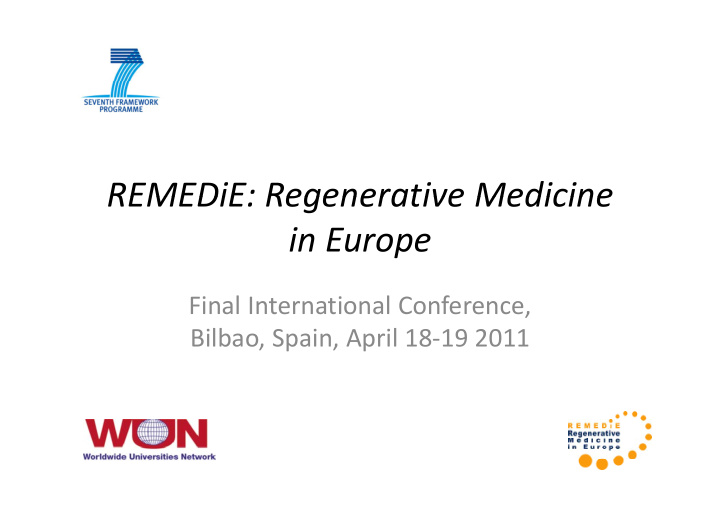



REMEDiE: Regenerative Medicine REMEDiE: Regenerative Medicine in Europe p Final International Conference, Final International Conference, Bilbao, Spain, April 18 ‐ 19 2011
REMEDiE: Introduction Professor Andrew Webster Professor Andrew Webster Final International Conference, Bilb Bilbao, Spain, April 18 ‐ 19 2011 S i A il 18 19 2011
Principal objectives of REMEDiE Principal objectives of REMEDiE • A detailed examination of the political economy of A d il d i i f h li i l f globalised regenerative medicine, applying this to highly significant policy and public issues within highly significant policy and public issues within Europe • An integrated series of projects organised around • An integrated series of projects organised around three inter ‐ related streams of research – markets, politics bioethics politics, bioethics • The development of a global database to identify global (inter ‐ related) trends and to map these global (inter related) trends and to map these
www.york.ac.uk/satsu/remedie y / /
Some key developments over past 3 years in the RM field The science : rapid scientific engagement with iPS reprogramming of adult cells from one cell type to another p g g yp genomic sequencing to determine pluripotency and so aid manipulation of cells tracking systems for determining ADRs from implants Regulation: First INDs given to hESC clinical trials (Geron/Reneuron), but continuing regulatory impasse in US (see blastocyst/blastomere) China and India’s engagement with international regulation Corporate: Emergence of user ‐ groups to respond to regulatory demands – establishment of ‘ATMP Bioprocessing Community ‘ in the UK Consolidation of primary hubs of activity in Europe (Germany, UK, F France) and US ) d US Greater engagement of big Pharma – Pfizer, AstraZeneca, GSK etc Clinical: Clinical: In Europe In Europe – steady growth of patient ‐ specific cell services model steady growth of patient specific cell services model seen as main therapeutic route for next decade (often via ‘hospital exemption’)
Framing RM…its promise, boundaries and challenges A bio/cultural change ‐ ‘A…more malleable concept of biological limits,…a movable threshold between surplus and waste, obsolescence and renewal.’ (Cooper, 2006) A prospective change in practice: RM as Medicine 2.0 – A prospective change in practice: RM as Medicine 2.0 translation of science into clinical practice: ‘tissue engineering has been replaced by cell therapy’ with strong public support’ (Mason, 2007) A paradigm change in corporate/clinical relations? A paradigm change in corporate/clinical relations?
Some key issues for the Conference: The geographical and technological stratification of the European RM sector, its • diverse (and highly uneven) markets, innovation strategies and its implications for appropriate policy ‐ making The distinctive innovation and governance models being developed in different • regions regions The specific challenges and risks associated with developing large ‐ scale trials in • the area and pressures towards harmonisation across Europe the area and pressures towards harmonisation across Europe The emergence of indirect forms of commercialization of oöcytes for reproductive • and research purposes and the regulatory challenges that need to be addressed here The emergence of distinctive and competing bioethical networks that frame RM in • very different ways. Overall: How to compare the UK/EU/US/and wider global developments?
Recommend
More recommend